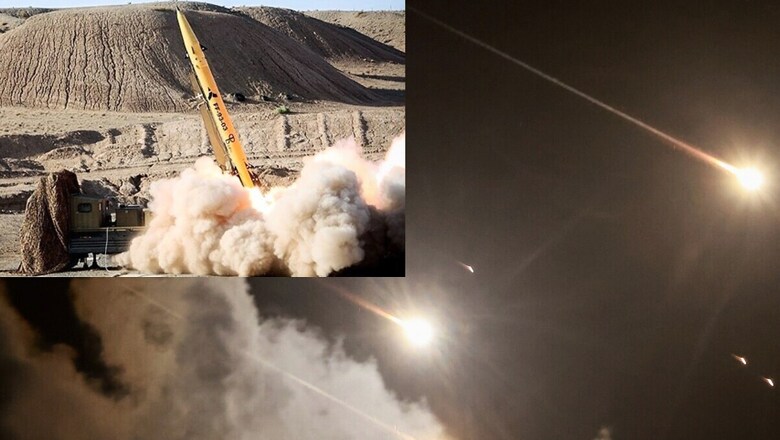
398
views
views
Iran launched its largest missile attack on Israel, utilizing hypersonic Fattah missiles with 90% accuracy. Explore the implications of this unprecedented escalation
Iran said on Wednesday its missile attack on Israel on the Jewish state was over barring further provocation, while Israel and the United States promised to retaliate against Tehran as fears of a wider war intensified.
Among the ballistic missiles that were used in the operation were Ghadr and Emad, as well as the latest Fattah hypersonic missiles, with Tehran claiming that 90 percent of the missiles hit their intended targets.
Fattah hypersonic missile
- The Fattah-1 hypersonic missile was unveiled last June in a ceremony attended by the late President Ebrahim Raisi, IRGC chief Major General Hossein Salami, and IRGC aerospace commander Brigadier General Amir Ali Hajizadeh.
- Named Fattah (meaning “the opener”) by Leader of the Islamic Revolution Ayatollah Seyyed Ali Khamenei, it is a precision-guided two-stage rocket powered by solid fuel.
- With a range of 1,400 km, the Fattah-1 is classified as a medium-range ballistic missile Its terminal speed is Mach 13 to 15 (16,000 to 18,500 kilometers per hour), three times faster than the lower limit of hypersonic speed (Mach 5).
- This speed, along with movable nozzles that allow the missile to maneuver in all directions both in and out of the Earth’s atmosphere, makes it immune to interception by all existing anti-missile systems.
- The main features of this sophisticated missile include advanced rocket engines, materials resistant to high temperatures, and complex guidance systems.
- In November last year, Iran presented the improved Fattah-2 model. While its first stage remains the same as the initial version, the second stage features a different warhead design.
- The Fattah-2’s solid fuel booster carries a gliding warhead, creating a new classification in this field: Hypersonic Cruise Glide Vehicle (HCGV).
- The Fattah-2 has a range of 1,400 km, a length of about 12 meters, and a weight of up to 4,100 kilograms, with a second stage weighing 500 kg, of which 200 kg is the explosive charge.
Ghadr and Emad missiles
- The Ghadr missile family, introduced in 2005, is an improved variant of the Shahab-3 medium-range ballistic missile, which Iranian military forces have used since 2003.
- It is a two-stage rocket with a liquid-fuel first stage and a solid-fuel second stage, produced in three types: Ghadr-S with a range of 1,350 km, Ghadr-H with 1,650 km, and Ghadr-F with 1,950 km.
- The Ghadr missile measures between 15.86 to 16.58 meters in length and has an airframe diameter of 1.25 meters, with an overall weight of 15 to 17.5 tons.
- The increased length compared to the earlier Shahab-3 accommodates stretched fuel and oxidizer tanks, carrying an additional 1,300 to 1,500 kg of propellant, allowing its engine to operate for an extra ten or more seconds.
- To offset the added propellant mass, the missile’s airframe is constructed using lighter aluminum alloy components, reducing the inert weight by about 600 kg compared to the all-steel version.
- The warhead mass has also been reduced from 1,000 to 650 kg, increasing the missile’s range from 1,200 to almost 2,000 kilometers.
- The Ghadr missile features a reshaped “baby-bottle” warhead design, improving aerodynamics and precision. The redesigned warhead, combined with a more advanced guidance system, reduces the circular error probability (CEP) from 2,500 to 100-300 meters.
- The Emad ballistic missile is an improved version of the Ghadr, with upgraded guidance and accuracy, tested and put into service at the end of 2015.
- It features a newly designed maneuverable warhead with fins on its base, enabling it to steer towards a target after re-entering the atmosphere.
- According to Iranian military officials, it is capable of guidance and control all the way to the point of impact, making it Iran’s first precision-guided missile.
- The Emad missile is powered by liquid fuel, has a length of 15.5 meters, a mass of 1,750 kg, a range of 1,700 km, and a CEP of 50 meters.


















Comments
0 comment